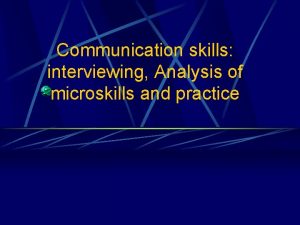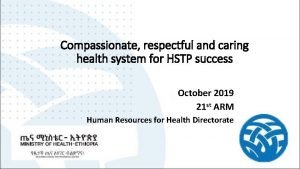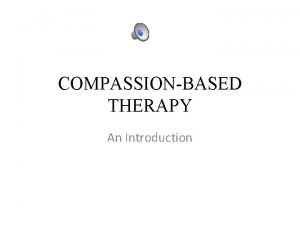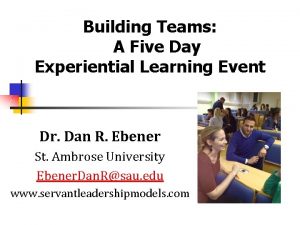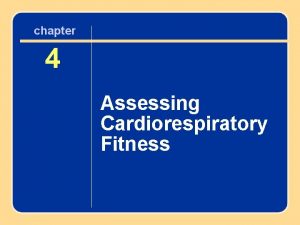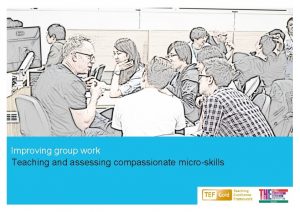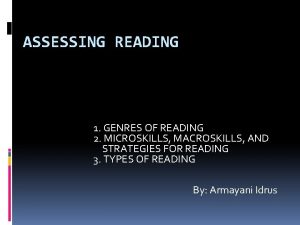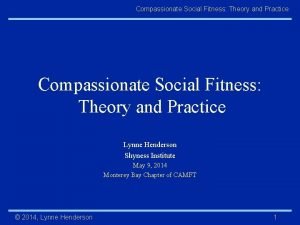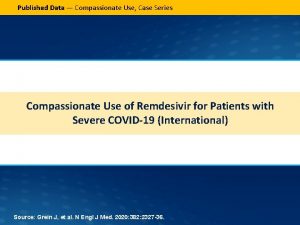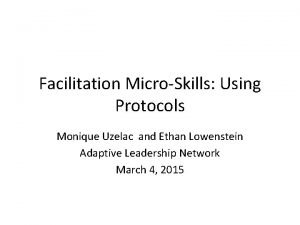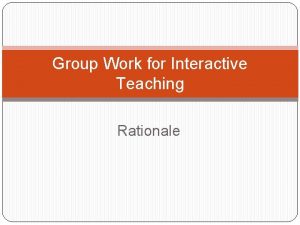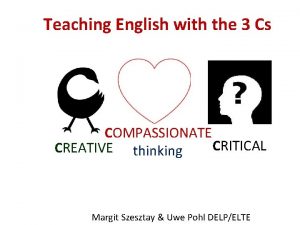Improving group work Teaching and assessing compassionate microskills


![What is “Compassion”? Behaviour, not emotion Noticing [not normalising] the distress or disadvantaging of What is “Compassion”? Behaviour, not emotion Noticing [not normalising] the distress or disadvantaging of](https://slidetodoc.com/presentation_image_h/1821d4b2820efcf7aaa05bb9808ade9d/image-3.jpg)





























- Slides: 32

Improving group work Teaching and assessing compassionate micro-skills

What are we going to do • Define what we mean by compassion • Look at why we are advocating this • Give overview of how to introduce concept to student groups, including how it may be assessed • Practically experience some of the teaching techniques • Share resources to support participants incorporating in their practice
![What is Compassion Behaviour not emotion Noticing not normalising the distress or disadvantaging of What is “Compassion”? Behaviour, not emotion Noticing [not normalising] the distress or disadvantaging of](https://slidetodoc.com/presentation_image_h/1821d4b2820efcf7aaa05bb9808ade9d/image-3.jpg)
What is “Compassion”? Behaviour, not emotion Noticing [not normalising] the distress or disadvantaging of yourself, others and Doing something (wise) to reduce or prevent that • What do I do in this group work to develop my fellow students’ learning experiences? • What do my fellow students do in this group work to develop my learning experiences?

Why do we teach compassion? • Record levels of anxiety and stress recognised across the sector • Diverse and large student populations • Promotes belonging, recognised as a key factor in student success • Improves interaction, critical thinking, engagement and cohort cohesion • Develops graduate attributes, including respect for others

Please join our study • Note: we have an ongoing project to collect responses before and after discussing compassion with groups. If you are taking this approach with students it would be great if you could use these surveys at the beginning and end of the module in which they learn about them: • https: //tinyurl. com/UHCFPstart • https: //tinyurl. com/UHCFPend

Three Circles model of the brain The Compassionate Mind • At its simplest we are seeking to instruct students to interact in a way which maximises the chance of higher level thinking • This involves training in skills which calm our threat system. • The threat system alerts us to danger. But this can be unhelpful. It is dominant: • Suppose you are out shopping all day. 20 shops assistants are delightful and one is rude. Which interaction do you find it hardest to get out of your head? • Can you think of your own example like this?

Why do we teach compassion? Evidence from recent practice • ‘I’m convinced that it’s compassion …I'm closer to this group of students than to any group I've taught in years. Many of my students are saying it’s the most exciting learning experience they’ve had at university. They didn't know, they said, that learning could be like this…This is life-changing work. ’ Prof Karen Edwards, University of Exeter • The feedback from this session was absolutely phenomenal. I had about 30 emails from students saying how much it had affected them; how much they were more compassionate to each other. ’ Debbie Sharp, Midwifery, UH • I showed my Business PG students the compassionate micro skills to use in their group work. They were so grateful I could have cried. ’ Norton-Bertram-Smith, University of Aberdeen

Teams working in the world beyond university have researched what makes them most effective Project Aristotle: more than the sum of its parts • 180 teams • 250 attributes • $5 million • 200+ interviews What do you think the key characteristic was?

How can it be incorporated in teaching? • Explain compassion • Organise some practical group exercises: • Speed meeting • Individual and collective reflection on list of unhelpful behaviours derived from research • Instruct in specific unhelpful and helpful behaviours • Return to regularly to establish as the normal way of interacting Many colleagues assess this activity, and in addition to the above also: • Introduce assessment schemes • Coach interaction weekly • Film discussion for assessment • Require submission of written self reflection on experience of group work

Next phase: Practical exercises to use with your students

The speed meeting How to introduce new students to each other. Fun and quick • Arrange the group in two lines facing each other • Pick a topic to discuss. , eg a favourite film/book/holiday, the best meal, preferred way to travel, worst ever trip, a boring fact about yourself…. (substitute as required) Consider having a few questions to hand – so in larger groups people are not continually repeating themselves for long periods • Ask everyone to speak for 2 minutes to the person opposite • Bring the conversation to an end • Ask one line stay still while everyone in the other moves along one place • Repeat the discussion • Enjoy until you’ve run out of time or everyone is back to their original partner • Don’t worry if anyone wants to sit out

Ask your group to reflect on their experience of group work Everyone should go through the list as honestly as possible, noting– note what they’ve experienced – indeed what they’ve done. Then discuss • Talking a lot so that others do not get many chances to speak. • Not inviting others to speak; not thanking others for their contribution. • Talking in silences when the shyest students are getting ready to speak. • Not speaking at all; becoming ‘too shy’ and so giving nothing to the group. • Fixing eye contact with the tutor only, or just one student and forgetting to look at all the other people in the group. • Not even reading a little bit in order to bring something to the discussion. • Letting other people talk and talk without • Using difficult language; not explaining difficult interrupting them. words or expressions so that other people in • Letting them use difficult words or the group cannot understand expressions. Allowing them to speak too • Not listening carefully to other peoples' ideas fast for everyone to understand them. • Not helping other people when they are • Not asking for more explanations when getting into difficulty while they are speaking. understanding is becoming too difficult Instead taking control and their chance to speak away from them. Talking over them.

Look at the sort of behaviours which will be rewarded – by marks if this is assessed – by greater criticality and cohesion even if not • Eye contact: multiple disciplines show it is important for inclusion. Are members looking at everyone as though the group were one person? • If people are anxious they may lock eye contact with one person to the exclusion of others (forming “an alpha pair”) • Active listening: body language, nods, questions • Body language: leaning in/leaning out? • Is everyone involved? How aware members of the group of each other? Is discussion being encouraged? Are participants inviting each other to contribute? Are they respectfully building on each other’s points? When responding to a presentation, are all members of the group encouraged by inclusive gaze? • Honesty ? Bravery in admitting not knowing. Inviting explanation – being specific

Fishbowl Watch and critique using the list of behaviours • Organise students into groups of about five, arranged so they can discuss a topic. Invite each group to choose one observer. • Provide a subject for discussion – maybe a disciplinary idea, though could in the first instance be experience of group work. • Groups should be invited to discuss the topic for 10 -15 minutes – ensuring everyone has a chance to contribute. • The observer should use the lists of helpful/unhelpful behaviour and make notes. They should signal by where they stand/sit that they are watching and not participating in the discussion. • Conclude by hearing feedback from observers about what they saw

Is the level of discussion appropriate? Remember to keep an eye on criticality too • It is important that students focus on how to develop critical argument alongside attention to their interactions. • For example, if group work is about each student researching and presenting an article, summary and critique of ideas should be encouraged. In the first few sessions it may be helpful to explain simply how to draw on evidence as they seek to make connections and respond to their peers. • Helpful forms of words can be offered to show this can be done- see resources section • The compassionate interaction should enable them to reach greater insight, it’s not about being kind.

Questions or concerns you may have • Shy students won’t like it? Encourage peers to leave space for them, be patient, invite responses and agree it’s ok to “pass” when not ready • Participants with Autistic Spectrum Disorder? This is about individual groups managing a way forward which works for all and each accepting their responsibility to do that. The focus on these as learned skills is helpful. • Culturally awkward? Compassion is a cross-cultural concept – works very well with diverse groups • Is it likely people will refuse to do this? This has not happened with any students, though some staff have anticipated an issue which has not materialised. • Will my externals object to assessing this? Where embedded this practice has been praised by externals. • Won’t the most confident students miss out? We have seen them realise by listening, summarising, analysing, their own thinking is also extended.

What if…. Students haven’t done the preparation On the day ask them to work extra hard on being involved in the discussion of others’ work and be clear the activity is needed for full participation in the module. Remember to keep mixing the group composition to help disrupt any unhelpful patterns of behaviour from establishing Inadequate preparation is done Discuss with student – if you’re not confident they have the skills pair them with TWO students who have done the preparation well. Ask them to assist the student in accomplishing something for next week. (Responsibility is shifted to the students – but not one on their own) Commend interesting articles to the whole group –if a student brings in work you intend to follow up, ask for references so everyone can hear. (Demonstrate that scholarly communities learn from each other) Help students by offering models/ words to introduce their papers

How might you take this forward? Options • Can simply introduce compassion at the outset to focus on how this can improve the process of learning. You will need reminders through the module if it is to become embedded • If weekly discussion is a key way of working for you consider adopting the assessment scheme • You could introduce compassion with the reflection questions and require written submission at the end of the module. • In all instances we ask that you ask students to complete survey about group work at beginning and end of module Discuss • Explain • Thread through sessions • Ask students to complete survey Assess interaction Reflection • Explain • Coach weekly • Film discussion • Grade • Explain • Pose questions • Require written reflection

How can this be built into a module Assessed discussion model Final session Homework Seminar One Speed meet What is compassion Helpful and unhelpful behaviours Explain assessment After each weekly class students carry out independent research on topic In weekly seminars In small groups students present in turns and discuss research they have done Tutor facilitates to support use of group management skills Small group sessions are filmed, each student assessed according to agreed criteria

How this can be built into a module Reflection on interaction model Introduction of compassion & reflection questions Regular reminders about way interact Encourage note keeping and thinking about interaction Ask students to review notes, write reflection and submit

Link to online survey • We are keen to evaluate the impact of compassionate microskills training on the student experience. • If you intend to introduce this work to your students please ask them at the beginning and end of the module to complete this short four-question survey: • https: //tinyurl. com/UHgroupwork • This is covered by the reflective practice protocol RE 01

What are you going to do next? • Try out with students in XXXX module? • Think & plan to assess – group behaviours or reflection • Consider use in staff meetings • Follow resources links to find out more • Other? Few minutes to write and then we’ll share together

Resources

Critiquing/reviewing articles/case studies Advice for students • Once you have found an article which meets the brief read it until you are clear what the writer is saying • It is your job first to summarise the main arguments in a few bullet points so you can explain it to your group easily • In preparation it is also important to ask yourself questions about what the writer says. Select a key point or interesting statement and then demand “why? ” or “how? ” • If you see the author does not answer your question, you might explain this Jones [2019] states/suggests that………but he does not explain why or how…… • You might also notice in your reading that an important issue is not mentioned. In this case you could say It is not clear why Jones does not consider/address/discuss…….

Advice for students A structure for your discussions Each of you should research an article and introduce it to your group every week. Hello colleagues, I would like to talk to you today about an article by …(insert author’s name) (insert year written) on (insert subject) in (insert journal source). (The author) focuses on/highlights/argues that…… (summarise and explain for 3 - 4 minutes) Could we discuss this together now please? (everyone discuss for 4 -5 minutes) Thank you all. (Insert name), would you like to present your article now? • Use skills of interaction – everyone will benefit. • All of you are responsible for improving the discussion • Listen, ask questions, critique ideas, make connections. Agree or disagree respectfully and explain why

What to do when you are listening to a colleague’s presentation of their article Advice for students • Show you are listening: refer to list of positive behaviours • If the speaker is not including the whole group with their eye contact, you can look around to help them • Concentrate on what they are saying – do you agree with the writer they quote, can you make connections between this and other things you have read, or articles others in the group have brought? • When the discussion begins try to include evidence to back up points • Phrases which might help: • I thought that……. was a particularly interesting point…it reminded me of ……. which I read/the point X made in ……… • Although that was a strong argument, I think the work of …. . would suggest there is a more to consider here…. .

Helpful group behaviours with more specific focus on case study task 1. Contributing to a relaxed, respectful atmosphere within your team 2. Being engaging, inclusive, encouraging, supportive 3. Considering suggestions from peers constructively to develop ideas 4. Asking questions to analyse a certain case study and make it more insightful 5. Communicating efficiently to agree on methods, goals and story content 6. The final production of an interesting solution and your ability to identify a short, appropriate and effective title 7. Listening and ensuring everyone gets involved

Conversational moves • Ask a question or make a comment that shows you are interested in what another person says • Ask a question or make a comment that encourages another person to elaborate on something they have already said • Make a comment that underscores the link between two people's contributions • Use body language to show interest in what different speakers are saying • Make a specific comment indicating how you found another person's ideas interesting/useful • Contribute something that builds on, or springs from, what someone else has said. Be explicit about the way you are building on the other person's thoughts • Make a comment that partly paraphrases a point someone has already made

Conversational moves • Make an summary observation that takes into account several people's contributions & that touches on a recurring theme in the discussion • Ask a cause and effect question - for example, "can you explain why you think it's true that if these things are in place such and such a thing will occur? " • When you think it's appropriate, ask the group for a moment's silence to slow the pace of conversation and give you, and others, time to think • Find a way to express appreciation for the enlightenment you have gained from the discussion. Be specific about what it was that helped you understand something better • Disagree with someone in a respectful and constructive way • Create space for someone who has not yet spoken to contribute to the conversation

Content of your group discussions will be graded using these criteria (70%) The research undertaken by the candidate for the topic is A demonstrated to be extensive; it is appropriate in content, level and relevance. (30%) Critical perspectives - as in questions posed, arguments offered, analytical and or evaluative insights into the student’s own research and that contributed by others - are integrated relevantly A and helpfully into the group discussion. The student helps keep the group focussed on task. (40%) B B C C D D E Little or no evidence is offered of sufficient and/or appropriate research. E Few or no critical perspectives – as in questions posed, arguments offered, analytical or evaluative insights into the student’s own research and that contributed by others – are demonstrated during the discussion. The student may contribute little by remaining silent, or else may input in ways that lead the group off task.

Body Language (10%) Eye contact and other body language is appropriately inclusive. Language (10%) is graded (it is international English and it is appropriately paced). It is also mindful in other aspects when: Disagreeing and/or critiquing Questioning Enacting inclusivity skills (see below) Group management strategies (10%) Eliciting , encouraging, acknowledging Accommodating reasonable hesitations/silences while less confident speakers are engaging the group’s attention Checking understanding of the group when speaking Intervening proactively and compassionately in the excluding behaviours of others, e. g. monopolising A B 100 80 C 60 60 D 40 40 E 20 20 Body language is signalling little interest or engagement with what is being said by others; or, may focus repeatedly on some students to the exclusion of others. Student may: speak too fast; or too quietly use excluding, localised English use inappropriately individualistic or disrespectful language when challenging or questioning others, or when enacting some group management strategies. Student may: tend to monopolise discussion or speak over others Student may make little or no attempt to: check the group’s understanding (of his/her own research) e. g. when presenting an unfamiliar term/concept get clarification when it is needed during presentations listen to and respond relevantly to others proactively support the efforts of others to contribute effectively to group task achievement.

Two Key questions to consider on a module. • What do I do in this seminar/group work to develop my fellow students’ social and learning experiences? • What do my fellow students do in this seminar/group work to develop my social and learning experiences?
 Microskills in teaching
Microskills in teaching Ways to address grammar in the writing classroom
Ways to address grammar in the writing classroom Microskills in communication
Microskills in communication 4 oars microskills
4 oars microskills Using assessment data for improving teaching practice
Using assessment data for improving teaching practice Group discussion is a modern method of assessing
Group discussion is a modern method of assessing Compassionate respectful and caring
Compassionate respectful and caring Examinations office uoa
Examinations office uoa Example of compassionate letter to yourself
Example of compassionate letter to yourself Compassionate ottawa
Compassionate ottawa Allahumma ishfi bi rahmatika
Allahumma ishfi bi rahmatika In the name of allah the compassionate the merciful
In the name of allah the compassionate the merciful Allah the compassionate
Allah the compassionate The most compassionate
The most compassionate Compassionate capitalism definition
Compassionate capitalism definition Compassionate extubation
Compassionate extubation Remedial model
Remedial model Work group vs work team
Work group vs work team Smart work vs hard work group discussion
Smart work vs hard work group discussion Comparison between micro teaching and traditional teaching
Comparison between micro teaching and traditional teaching Career stage of ppst
Career stage of ppst Formal and informal reading assessments
Formal and informal reading assessments Assessing a new venture's financial strength and viability
Assessing a new venture's financial strength and viability Assessing leadership and measuring its effects
Assessing leadership and measuring its effects Module 4 topic 1 assessing and managing risk
Module 4 topic 1 assessing and managing risk Module 4 topic 1 assessing and managing risk
Module 4 topic 1 assessing and managing risk Assessing risk in sport
Assessing risk in sport Unit 18 assessing children's development support needs p1
Unit 18 assessing children's development support needs p1 Task analysis in hrd
Task analysis in hrd Manual for assessing safety hardware
Manual for assessing safety hardware Chapter 4 cultural dynamics in assessing global markets
Chapter 4 cultural dynamics in assessing global markets Assessing cardiorespiratory fitness
Assessing cardiorespiratory fitness A nine box matrix requires assessing employees on ________.
A nine box matrix requires assessing employees on ________.


